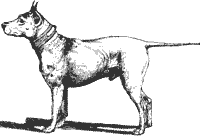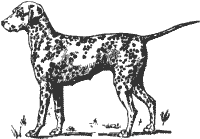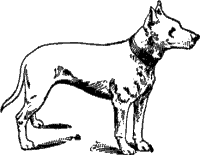 | |
Deaf Dog Education Action Fund |
| Home | | | FAQs | | | | | Resources | | | Rescue | | | You Can Help |
Training Your Dog With A Vibrating Collar
We expect our dogs to listen to us when we speak to them and our dogs, no less than we, do expect us to listen to them.
- Roger Caras
 All dogs need training - they just need to learn what each sound or gesture means. No one would assume that just because a dog can hear that he will come running back to you if you call him. You need to train the dog to respond to your voice commands. The same applies to a deaf dog. You have to teach him to respond to your commands. The biggest difference between a hearing dog and a deaf one is that you can't use your voice to get the dog's attention. If he is across the room or across the field and doesn't look at you, you can't yell to him, direct him, or summon him back to you. If your deaf dog gets loose, it can be a terrifying experience - will he look at me? If he doesn't look at you, you can't communicate. These types of experiences, and the wish to be able to better communicate with deaf dogs, has lead to the development and use of the vibrating collar.
All dogs need training - they just need to learn what each sound or gesture means. No one would assume that just because a dog can hear that he will come running back to you if you call him. You need to train the dog to respond to your voice commands. The same applies to a deaf dog. You have to teach him to respond to your commands. The biggest difference between a hearing dog and a deaf one is that you can't use your voice to get the dog's attention. If he is across the room or across the field and doesn't look at you, you can't yell to him, direct him, or summon him back to you. If your deaf dog gets loose, it can be a terrifying experience - will he look at me? If he doesn't look at you, you can't communicate. These types of experiences, and the wish to be able to better communicate with deaf dogs, has lead to the development and use of the vibrating collar.
A vibrating collar is a training collar that allows a person to press a button on a remote control device, which then sends a signal to the collar, causing it to vibrate. The effective distance will depend on the type of collar you buy (or make), and can vary depending on model (check out our Information page for where to get a vibrating collar). The vibration is not a shock and is not very strong. In fact, many people who have used the collars worried at first that they wouldn't work because the dog didn't even seem to notice. But with conditioning and training, your dog will respond to the vibration.
The vibration signal for a deaf dog becomes the equivalent of using voice to get the attention of your hearing dog. Many people just assume that since their dog can hear them, it will obey them when off-leash, which is not the case. Every dog is trained and obeys at a different level. This is true of a deaf dog using a vibrating collar also. Every dog must be treated and seen as an individual and you must take that into account. Each dog will be different and it will depend on your dog - and your comfort level - if your dog can ever be let off-leash, even using a vibrating collar.
Before You Start
 A vibrating collar is not the answer to your training problems. It is not a magical device that will make your stubborn or rambunctious pup pay attention to you. It is a tool that will allow you to better communicate with your deaf pup. Before you start working with a vibrating collar, there are some basic commands that your dog should know, especially before you move on to Step 3: Training the Dog to Respond When Paged. Your dog should be consistently responding to the following commands: sit, stay, and come. You can find explanations on how to teach these commands (and examples of what signs to use) on our Signs page. A vibrating collar is used to get the dog's attention when he isn't looking at you, it doesn't take the place of any other basic training that your dog might need.
A vibrating collar is not the answer to your training problems. It is not a magical device that will make your stubborn or rambunctious pup pay attention to you. It is a tool that will allow you to better communicate with your deaf pup. Before you start working with a vibrating collar, there are some basic commands that your dog should know, especially before you move on to Step 3: Training the Dog to Respond When Paged. Your dog should be consistently responding to the following commands: sit, stay, and come. You can find explanations on how to teach these commands (and examples of what signs to use) on our Signs page. A vibrating collar is used to get the dog's attention when he isn't looking at you, it doesn't take the place of any other basic training that your dog might need.
Steps for Using A Vibrating Collar
- Introducing the Collar to the Dog
- Introducing the Vibration to the Dog
- Training the Dog to Respond when Paged
Introducing the Collar to the Dog
Before you begin to train your dog with the collar, you must first introduce the collar to her. Most vibrating collars are about as big as an average sized bar of soap. Some vibrating collars need to be attached to a regular collar, and some come already connected to a collar. In either case, it is something new for your dog and you need to give her time to become accustomed to it. You don't want the collar itself to be a distraction.
Follow the manufacturer's instructions for fitting the collar. It should fit snugly enough so that the prongs are touching the dog and doesn't move much, but not so tightly that it interferes with normal behavior. Let the dog wear it for short periods for the first three days. Resist the urge to test the vibration on the dog during this period . Take several days and wait until your dog is comfortable with the collar. Start out gradually and use positive reinforcement and treats to convince your dog that she shouldn't mind the collar.
- Day 1
- Put the collar on, treat, take it off, treat - several times throughout the day.
- Day 2
- Put it on for 15-30 minute intervals - always treat when putting on/taking off the collar.
- Day 3
- Leave on for longer periods: again, treat when putting on/taking off the collar.
- Note:
- If the collar does not seem to bother your dog on the 2nd day, then you may want to leave it on for longer periods, gradually working up to leaving it on any time you're with the dog. It is not a good idea to leave the collar on the dog while she is alone or unsupervised. (You shouldn't leave any collar on a dog unsupervised, as it could get caught on something and if your dog should happen to get it off and chew it up, it's a pretty expensive thing to replace.)
Introducing the Vibration to the Dog
 Imagine you have a hearing puppy. When he is very small, you talk and talk and he has no idea what those sounds mean. You have to teach him, through repetition and positive reinforcement, that those sounds have meaning. It is the same when you start teaching signs to your deaf dog. It takes repetition for him to understand what you want. This also applies to teaching your dog the meaning of the vibration. Most people who have introduced a vibrating collar to their deaf dog got one of two responses, and sometimes both. Either the dog totally ignored it, or he was slightly startled and looked around for the source of the vibration. Don't worry. If your dog seems to ignore the vibration at first, it doesn't mean the collar is useless or defective.
Imagine you have a hearing puppy. When he is very small, you talk and talk and he has no idea what those sounds mean. You have to teach him, through repetition and positive reinforcement, that those sounds have meaning. It is the same when you start teaching signs to your deaf dog. It takes repetition for him to understand what you want. This also applies to teaching your dog the meaning of the vibration. Most people who have introduced a vibrating collar to their deaf dog got one of two responses, and sometimes both. Either the dog totally ignored it, or he was slightly startled and looked around for the source of the vibration. Don't worry. If your dog seems to ignore the vibration at first, it doesn't mean the collar is useless or defective.
Once your dog has become accustomed to wearing the collar, your next step is to "explain" to your dog that you are causing the vibration, and that it means that you want something, even if that is only his attention. Be sure to start this step with no distractions. Keep your dog on a leash and close to you for this phase of the training. Page the dog (press the remote so that the collar will vibrate) and immediately give him a treat. Don't wait for him to look at you or respond in any way to the vibration: page-treat, page-treat. Do this about ten times (giving your dog time to eat the treat, naturally) and then quit. Keep the first few sessions short, approximately 5-10 minutes each. Leave the collar on your dog and repeat the sessions throughout the day (2-3 times is good). The main purpose is to get him used to feeling the vibration and to associate it with you.
 Continue to train in this manner, keeping the dog close to you. Don't move too quickly to the next step. Just because your dog looks at you once when you page him doesn't mean that you're ready to move on to the next step, especially if he still seems not to notice the vibration at other times. If he does look at you, add a "good" sign, but continue to treat every time you page regardless of whether he looks or not. After the first day, try pausing briefly after about the 3rd or 4th page to see if your dog will look at your for his treat. If he looks, give a "jackpot" (several treats instead of just one), and quit for that session. If he doesn't look, continue to page-treat as before. As you work on this step, you can begin to introduce normal household distractions: other dogs, cats, kids walking around the room. You will be ready to move onto the next step when your dog seems to be consistently responding in some way to the vibration.
Continue to train in this manner, keeping the dog close to you. Don't move too quickly to the next step. Just because your dog looks at you once when you page him doesn't mean that you're ready to move on to the next step, especially if he still seems not to notice the vibration at other times. If he does look at you, add a "good" sign, but continue to treat every time you page regardless of whether he looks or not. After the first day, try pausing briefly after about the 3rd or 4th page to see if your dog will look at your for his treat. If he looks, give a "jackpot" (several treats instead of just one), and quit for that session. If he doesn't look, continue to page-treat as before. As you work on this step, you can begin to introduce normal household distractions: other dogs, cats, kids walking around the room. You will be ready to move onto the next step when your dog seems to be consistently responding in some way to the vibration.
Training the Dog to Respond when Paged
Once again, be sure to start this step free from distractions. Once your dog seems to be responding to the page and maybe even looking at you fairly regularly when you page her and give her a treat, you can stop just popping treats into her mouth. You'll know when she's ready for this next step. Now, require her to look at you. Page her, and if she looks, give her a treat. If she doesn't look at you, you have several options. Remember, you should only move on to this next step when you know that she's associatingthe vibration with the treat. Possible options are:
- Page her, and if she doesn't immediately look at you, put your hand (with a treat in it!) in front of her nose and draw it up to your face so that she follows the treat and looks at you, then give her the treat (you can give her the "look" command at this point also).
OR - At the same time that you're paging her, get her attention, either with your hand (holding a treat in that hand and moving it in front of her face), or stomping on the floor, or whatever method you usually use to get her attention, and then give her the "look at me" sign. When she's looking at you, give her the treat.
Your goal in this close work is to reach the point where your dog is consistently looking at you every time you page her. A dog trained to look at its handler when paged will also come find the handler if she is out of visual range. You can gradually move away from keeping your dog very close to you. Begin to work with her by letting her off the leash, but keep her in the same room with you. Continue free from distractions and page her. When she looks at you, give her a command, and when she does that, give her a treat (if you ask her to sit or down, go to her to give the treat). At this point, it would be helpful (though not absolutely necessary) if your dog knows a "stop" or "stay" command - so if your dog decides that the vibration means to come to you - you can tell her to "stop", then give the command that you want her to obey (sit, stay, down, whatever). A mistake that has been made is to usually give the "come" command: that has lead to the dog believing the page is always a "come" command, rather than a "look" command. Once she is responding when there are no distractions, start introducing normal distractions. Let her wander around the room, and when she's not looking at you, page her. When she's sniffing around the floor, page her. Introduce the distractions gradually. With any training, you do not want to move from no distractions to trying to get her attention when she's focused on the mailman at the front door!
 As with all training, if your dog does not respond to the command, you are probably moving too fast. First, try to determine whey she didn't respond: are there too many distractions; did you move to the next step before she was ready? At this point, if she's not responding, you may want to take a step back. If you're paging her when she's wandering around the room and she's not responding, go back to working with her on a leash close to you.
As with all training, if your dog does not respond to the command, you are probably moving too fast. First, try to determine whey she didn't respond: are there too many distractions; did you move to the next step before she was ready? At this point, if she's not responding, you may want to take a step back. If you're paging her when she's wandering around the room and she's not responding, go back to working with her on a leash close to you.
Once your dog is consistently responding by looking at you whenever you page him, then you can start to vary the remote training outdoors. Let your dog roam the house: first, in the same room, and later, out of visual contact with you. Don't hide - just go about your normal activities - but let your dog leave your visual range. Page him once. When he comes to you, treat him. If he doesn't comply by coming to your page, go get him. Do not repeatedly page him again, as repeatedly paging may cause the dog to "forget" what the "buzz" means, and it will become meaningless. Do not punish your dog for not coming: going and getting him will let him know that you wanted him. Again, if he is not responding and you have to go get him, figure out why. Is it because he's too distracted when you're not near him? Maybe the treat you're using is not as enticing as the fun he's having. One of the advantages of a collar that has a vibration/tone mode is that you can hear if the signal is reaching him, so you'll know if he is ignoring you, or if he just didn't get the signal. You want to be sure that your dog understands that the vibration from the collar means "look at me" or, if he can't see you, then it means "come." In order for this to work in emergencies, you need to reach the point when your dog will come whenever, and from wherever, he's paged.
Once you have consistent results indoors, move outdoors. This will be like starting over. You may even need to begin again with the page-treat, page-treat stage. Do the beginning work up close as before, with the dog on-leash. Use a long line for distance work, graduating to off-leash (in a fenced area, of course).
 The keys to training your dog to respond to a vibrating collar are, as with any training, patience and consistency. In the early stages of training, treat your dog every time you page him, even if it seems as though he ignores the vibration. The dog may not understand what the vibration is, where it is coming from, or that you are causing it. But eventually, the dog will associate the vibration from the collar with treats. Your dog may respond immediately, after 3 tries, after 20 tries, etc. Don't give up! Your dog will respond eventually. As he becomes more reliable with responding to the vibration, then you can also begin to vary the treats. Also, do not ever reprimand your dog when you page and he comes to you. You want to be sure that he associates coming with good things like treats and praise (you don't want him to even consider whether or not it will be a good idea to respond this time). Remember, as with any command, it is important to practice regularly, and use some sort of reward all the time (treats, praise, whatever works best for you and your dog). And above all, remember, you and your dog should be having fun!
The keys to training your dog to respond to a vibrating collar are, as with any training, patience and consistency. In the early stages of training, treat your dog every time you page him, even if it seems as though he ignores the vibration. The dog may not understand what the vibration is, where it is coming from, or that you are causing it. But eventually, the dog will associate the vibration from the collar with treats. Your dog may respond immediately, after 3 tries, after 20 tries, etc. Don't give up! Your dog will respond eventually. As he becomes more reliable with responding to the vibration, then you can also begin to vary the treats. Also, do not ever reprimand your dog when you page and he comes to you. You want to be sure that he associates coming with good things like treats and praise (you don't want him to even consider whether or not it will be a good idea to respond this time). Remember, as with any command, it is important to practice regularly, and use some sort of reward all the time (treats, praise, whatever works best for you and your dog). And above all, remember, you and your dog should be having fun!
| Home | | | FAQs | | | | | Resources | | | Rescue | | | You Can Help |
© Copyright DDEAF, 1998-2024